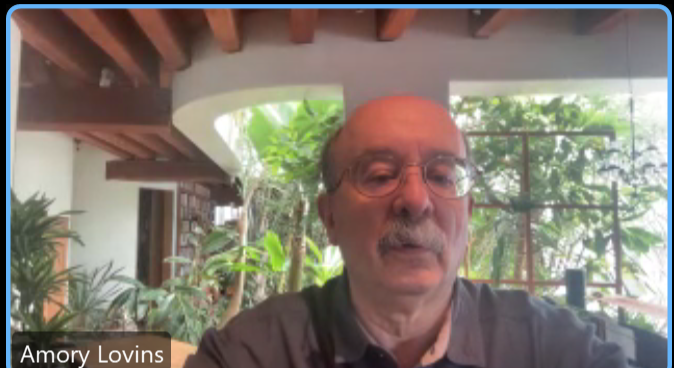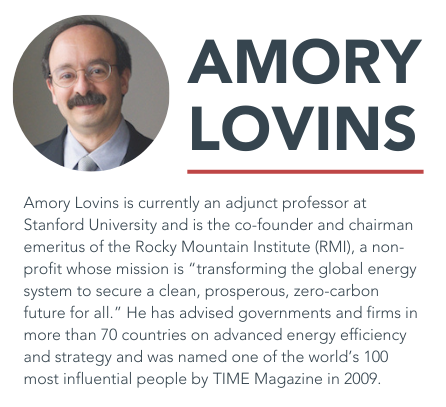Q&A: Amory Lovins shares his thoughts on grid transformation, energy efficiency, electricity load growth, supply chain and more
In February, ReliabilityFirst welcomed Amory Lovins, co-founder and chairman emeritus of the Rocky Mountain Institute (RMI) and adjunct professor at Stanford University, to Technical Talk with RF to discuss socio-economic impacts of the great energy transition. In the past, RF has talked with different voices about the grid of the future and what it may look like. In 2023, our State Outreach Webinar featured Lars Schernikau and Abe Silverman discussing contrasting views of how we solve the same problem.
There are many visions of what the grid of the future looks like. While ReliabilityFirst’s primary focus is reliability, hence our name, there are additional socio-economic impacts that must be considered when planning and operating the grid. We often talk about the “Energy Trilemma,” which is the delicate balance of reliability with cost and environmental impact. In RF’s independent, objective role, we aim to bring a wide range of voices to the table to discuss the socio-economic considerations of the grid transition, including the cost to consumers, supply chain, environmental impacts, land usage, job creation, recycling, and beyond. We like to look at case studies, not just from other parts of the United States, but from Europe and Australia, for example, as well. When we bring in experts to share their thoughts, the purpose is so that we can hear about different perspectives, even if they challenge our own vision of the grid of the future.
Lovins’ Tech Talk presentation spurred heavy engagement from our virtual audience and we ran out of time to get to all of our viewers’ questions. The questions in this piece were submitted by the audience and shared with Lovins, who offered his thoughts on them via email after the fact. Some questions and answers have been slightly edited for brevity and clarity.
As always, there are many visions for the what the grid of the future looks like, and Lovins’ answers are his own, and don’t necessarily reflect the views of ReliabilityFirst. Our views and analysis have been shared through our reports and written testimonies. However, we feel sharing this information helps us to continue the dialogue to open minds on what the energy transition may look like. The more we can collaborate, the better we can understand the risks, challenges, and most importantly the mitigations to ensure a reliable and secure energy transition.
Energy efficiency and energy transition costs
Question: Given the apparent cost-effective ways that redesign can reduce energy consumption, what is your sense of why companies and individuals are not flocking to replace their current equipment and buildings for cost-effective alternatives?
Amory Lovins: Few know what’s possible, and even fewer know how to do it or where to find people who can. People are busy and have other hassles with higher priorities. Progress usually starts with an enthusiast (at any level) willing to put in the time, and with the technical knowledge and diplomatic skills to make stuff happen.
In principle, utility demand-side efforts could help spread the word if we can find some that really want to innovate. Northeast Utilities also did well long ago by paying for design charrettes, so they’d have to pay much less (or nothing) for equipment rebates because good design would shrink or eliminate the equipment. I don’t know if that program still runs, but it sounds like a useful archetype, and could now focus on integrative design to save even more.
I co-teach at Stanford with Joel Swisher probably the only course on integrative design, and hope this year to put my lectures/slides online. Meanwhile, we’re soon starting internal distribution through the Indian Institute of Technology network (reaching ~3,000 higher-ed tech institutions across India), where I recently did a teach-the-teachers course in Madras/Chennai; later this year I’ll do the same in Australia and Sweden.
Ideas and collaborations welcome! There’s plenty of good work on advanced negawatts to be done for anyone willing to pitch in.
Question: How do we incentivize U.S. customer behaviors needed to help us balance the load and design, whether it be design of homes/buildings, or even just usage patterns?
Lovins: A nice review paper with 109 experiments in 24 residential pilot programs on three continents over 14 years showed that information, price, and technology work much better together than separately: “Time-Varying and Dynamic Rate Design,” 2012, Regulatory Assistance Project and The Brattle Group. The better programs cut peak loads by 30–50%-plus. Of course, very efficient buildings will have little or no weather-sensitive load to control or influence in the first place.
Question: Given that coal use seems to be the biggest environmental challenge to zero-in on first, is there a way to focus these developing areas where coal use is increasing and reduce coal use, such as by offering designs/use-cases and assistance essentially free as a way to benefit the planet as a whole?
Lovins: Yes. There is a great deal of such activity. The outfit I cofounded, rmi.org, does it all over the world, particularly in China and India. See e.g. carbontracker.org and, for the impressive results, see here. An excellent summary of why retiring coal power is economically advantageous for the countries that do it, even just in private internal cost, is located here.
Question: Do you have a sense of what time frame would be required to re-configure the U.S. (what appears to be) whole-sale change-out of industrial, housing, etc.?
Lovins: A few decades, more or less, depending on how serious how many of us get at reducing risks and grasping opportunities. It’s a very exciting time. You might enjoy our book Reinventing Fire (Chelsea Green, 2011) to dive into some of the interlocking drivers and opportunities.
Electricity load growth, including cryptocurrency, data centers and electric vehicles

Amory Lovins presents during the February 2024 edition of Technical Talk with RF.
Question: What do you see as the impact of crypto mining data centers?
Lovins: There is a great deal of coordinated misinformation nowadays forecasting gigantic load growth for Bitcoin mining and other (often spurious) purposes, as well as for the latest shiny object—AI learning. My friend Dr. Jon Koomey (ex-LBNL, Stanford lecturer, the best independent scholar of this subject) suggests some useful readings, since he’s been through several IT hype cycles, often promoted by the coal industry:
- “Recalibrating global data center energy-use estimates”
- “There’s plenty of room at the top: What will drive computer performance after Moore’s law?”
- “Implications of Historical Trends in The Electrical Efficiency of Computing”
- “Does not compute: Avoiding pitfalls assessing the Internet’s energy and carbon impacts.”
- “The Carbon Footprint of Machine Learning Training Will Plateau, Then Shrink.”
- For some history from two decades ago, which shows that this just keeps happening, and not by accident, please see the epilogue to Jon’s excellent 2017 book.
So I counsel strong caution. Many estimates lately published in normally reputable places look high by up to an order of magnitude. I foresee lots of prestranded supply-side assets and burned investors. Caveat lector.
And by the way, data centers have two to three orders of magnitude efficiency opportunities (hardware + software). The best one whose conceptual design I co-led would have saved (said our partner EDS) ~95% of its energy and half its capex, had the client allowed us to do that. (The client rejected most improvements, so we could only triple efficiency at the same capex—very disappointing.) Today’s techniques are even better. Data-center efficiency has made enormous strides since we launched it with a San Jose charrette by RMI in 2003 (!)—see here. I think the best PUE is now 1.04–1.05, but that’s only part of the story, as server and software efficiencies continue to advance.
Question: In January of this past year, around the MLK holiday, we saw news stories of electric vehicles (EVs) stranded due to depleted batteries due to the extreme cold. Do you think stories like this may impact EV sales, especially here in the Midwest?
Answer: I trust most buyers will be better informed than that. Some makes and models, especially certain older ones, do have poor thermal tolerance or control; others don’t. It’s never been an issue with my BMW i3 or Tesla Model 3 up here at 7100’ near Aspen, where it used to go to –47˚F. Also, while the reported episodes presumably did happen, poor driver planning was often implicated. And in general, reports generically critical of EVs are often technically unsound, and many come from oil-industry disinformation campaigns. (Sorry to have to say that, but I’ve worked in all these industries for decades.) So judge the evidence and source carefully.
Question: Do you think energy efficiency and savings are being wiped out by crypto currency, data centers, and other electrification efforts (and possibly the creation of green hydrogen)?
Lovins: No. U.S. electricity use continues roughly flat per EIA. The balance between these and other competing forces may tip either way in different places, e.g. with weak demand-side focus in Texas but strong in say Vermont or New York. However, there is a real, hard, and very important question about how much electricity the U.S. or the world will need in, say, 2050. I think that’s uncertain to ≥2x and probably to ≥4x, as my talk explained. That uncertainty keeps growing. Some of us at RMI aim to understand it much better in the coming months.
Risks to the grid, including supply chain
Question: Regarding renewable technologies, are you concerned about the U.S. dependence on China?
Lovins: Somewhat, but less about critical materials (a manageable issue being rapidly addressed) than about raw industrial capacity. China’s enormous, hundreds-of-GW/year surplus of photovoltaic module manufacturing capacity by the end of this year (when the total manufacturing capacity will pass 1 TW) implies ≥5 years of rock-bottom prices as glutted manufacturers struggle for cash flow by selling at or below cost. That makes it hard for other countries to start up their own new manufacturing capacity.
But of course, it’s a paradise for installers and customers, and will open up many big new markets. For my contrarian view on critical materials, see this article and the earlier (on rare earths). Amazing how hypesters fleece mine investors in one boom-and-bust after another—rare earths, cobalt, lithium, nickel, the list keeps growing. Also, amazing how little the official studies of critical materials are informed by hands-on knowledge of their end-uses, and hence of the opportunities for saving, substituting, or recovering scarce materials.
Question: Energy diversification is an important component to meet the growing demand for power, but the greatest threat is still the rudimentary. Vegetation management is noted in Gretchen Bakke’s, “The Grid,” as the greatest threat to the fraying wires… What plans are there to innovate in this area?
Lovins: Efficiency and demand response; distributed resources; undergrounding; ecosystem and hydrological restoration; paying real attention to vegetation mgt; smarter and stronger conductors with instant-sense-and-shutoff capability on break or big sag (tsconductor.com, to which [disclosure:] I’m a paid advisor); and of course slowing or reversing the underlying climate-change drivers. No doubt I’m missing something….
Question: Are you worried that demand response is just another name for either 1.) intentional load shed or 2.) backup diesel (dirty) generation?
Lovins: Not by well-informed good-faith actors. Your (1) and (2) should be called exactly what they are and nothing else.

